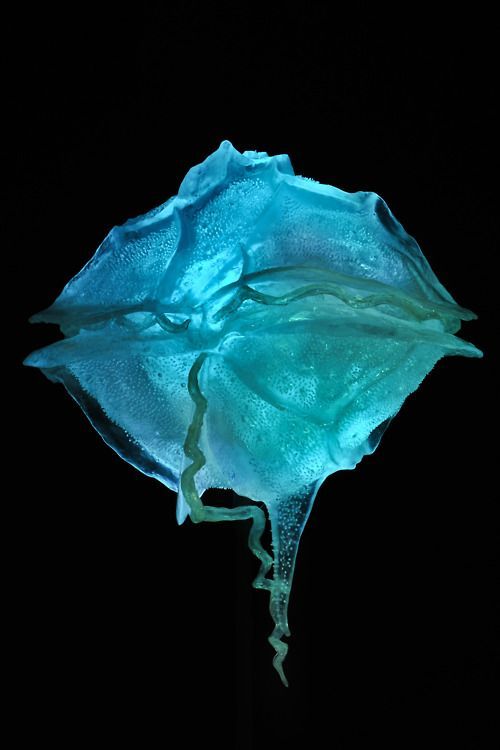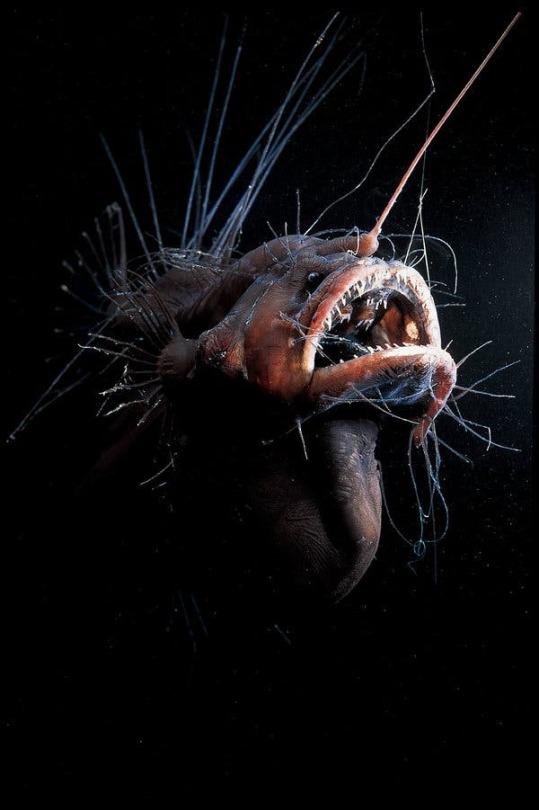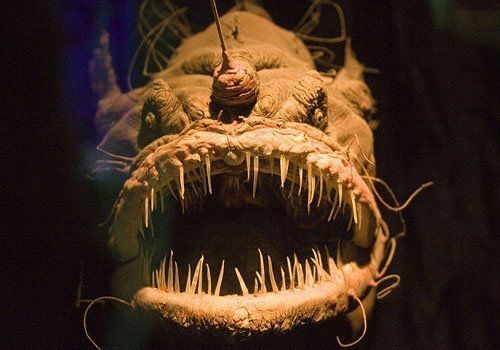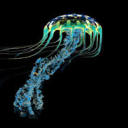Pram Bug

Pram Bug
Phronima sedentaria
The Pram Bug is a deep sea amphipod that is located between 200 to 1000m in the ocean. It has a translucent exoskeleton and can see primarily blue light. It is also is contained in a hollowed out barrel that is used for protection and to house babies. The image above is a female pram bug carrying its young.
Photo Credit:https://ocean.si.edu/ocean-life/invertebrates/phronima-female-and-young
More Posts from Bioluminescentoceangoddess and Others

Squarenose Helmetfish
Scopelogadus beanii
The Squarenose Helmetfish is found between 800m to 4000m in the ocean. It received this unique name due to its scales reminding scientists of an armored helmet worn by medieval knights. It also has unusual holes around its face, and the white strands covering its face are sensory canals.
Photo credit: https://www.vistaalmar.es/especies-marinas/peces-extranos/449-que-peces-mas-extranos.html
Pyrocystis fusiformis is a common plankton that produces bioluminescence. Not exactly a marine animal, but an amazing organism that produces bioluminescence. So, I thought it was worth sharing on this page.



Pyrocystis fusiformis
Pyrocystis Fusiformis is a marine dinoflagellate that is non-motile and has a short life cycle (5-7 days). When disturbed, the dinoflagellate displays vibrant, blue bioluminescence. The bioluminescence is design to startle grazers, or cause them to glow, making them more vulnerable to predators. During the day, it uses photosynthesis to produce its own food, and it produce bioluminescence at night. Furthermore, it fixes carbon from the ocean and produces oxygen for the marine animals that live there. All in all, I find this diamond shaped plankton to be unique and beautiful.
Photo credit: https://fineartamerica.com/featured/2-bioluminescence-of-pyrocystis-fusiformis-gerd-guentherscience-photo-library.html
https://exploringtheinvisible.com/2013/11/21/c-mould-new-acquisition-pyrocystis-fusiformis/
https://www.flickr.com/photos/13084997@N03/32823053106


Glowing sucker octopus
Stauroteuthis syrtensis
The Glowing Sucker Octopus can be found at 2500 m in the deep ocean. This unique creature has two fins that look similar to elephant ears. They move elegantly through the water by moving these fins and contracting their mantle. Evidence of this creature has only been spotted in the Atlantic Ocean.
Photo credit: https://octolab.tv/species/glowing-sucker-octopus/
https://ferrebeekeeper.wordpress.com/2011/03/14/glowing-sucker-octopus/


Pyrodinium bahamense
Pyrodinium bahamense is a tropical species of dinoflagellates that is found primarily in Atlantic Ocean waters. It prefers salinity around 20 psu and blooms when there are large amounts of nitrogen in the water. The dinoflagellate glows bright blue when agitated by motion. Furthermore, even though this plankton species is beautiful to look at, it causes seafood toxicity.
Photo credit: https://alchetron.com/Pyrodinium-bahamense
https://wonderchews.com/bodies-of-light/


Cigar Comb Jelly
beroe forskalii
The Cigar Comb Jelly is a gelatinous ctenophore that is marveled by many due to its sparkling bioluminescence. It tends to elegantly float around 120 m in the ocean. It uses unique, hair-like structures called ctens to move horizontally in the ocean. It also swims in a spiral pattern before consuming zooplankton in the ocean.
Photo credit: https://www.wrobelphoto.com/gelatinouszooplankton/h25347306
https://www.flickr.com/photos/a_migotto/27227530815


Fanfin Seadevil
Caulophyyne jordani
The Fanfin Seadevil is an ugly, deep fish that is covered in gnarled skin and long sensory filaments. The sensory filaments allow this species of anglerfish to detect movement in the water; this helps the Fanfin find and lure its prey. Furthermore, this deformed monstrosity can be found floating between 700m to 3000m in the ocean.
Photo credit: https://www.nytimes.com/2019/07/29/science/anglerfish-bioluminescence-deep-sea.html
http://www.robotspacebrain.com/alien-creatures-of-the-mariana-trench/


Cockatoo Squid
Galiteuthis phyllura
The Cockatoo squid is a highly-specialized oddity of the deep ocean and found at depths between 300 to 1400 m. It is completely transparent, except for its eyes. It also has bioluminescent photophores that are directed downward: this makes it difficult for deep sea predators to see the Cockatoo Squid. It was named after the Cockatoo because it holds its tentacles above its head, resembling the bird. The Cockatoo squid can also get fairly large with adults reaching lengths of 2.7 meters (over 6 ft.)
Photocredit: https://www.americanscientist.org/article/at-home-in-the-dark
https://www.pinterest.com/pin/28710516347382519/


Gulper Eel
Saccopharynx sp.
The Gulper Eel is known for its massive jaws, which are capable of swallowing prey whole. It’s stomach is also able to expand twice its size. It is found only in the deep see about 2000 to 3000 meters in depth.
Photo credit: https://www.youtube.com/watch?v=XRO0IjSoHGA
https://marinebiochemistrygc2018.weebly.com/deep-sea-adaptations
Sea sparkle is a common, bioluminescent plankton. Even though its not an animal, it is worth sharing.


Sea sparkle
Noctiluca scintillans
Sea sparkle is a bioluminescent dinoflagellate that blooms in many coastal waters. Sea sparkle feeds on plankton, diatoms, fish eggs, and other dinoflagellates. It also has a flagellum, or tiny tail, that helps it move around in the water. Even though sea sparkle is beautiful to witness at night, it is hazardous to other marine species and resembles a reddish-pink film during the day.
Photo credit:
https://alexandrathemb.tumblr.com/post/49814932878/noctilucas-scintillans-a-bioluminescent
https://thevelv.blogspot.com/2015/07/noctiluca-scintillans.html

Black Medusa
Vampyrocrossota childressi
The Black Medusa is an inky, black hydrozoan that absorbs all light that hits its tiny body. It has a translucent gelatin and a black umbrella; it is also only 1.5 cm in size. Moreover, it is found at depths between 600m to 1500m, and it spends its entire life floating in the deep ocean.
Photo credit: https://www.pinterest.com/pin/488148047080475827/
-
 stardustandmoonflowers liked this · 1 year ago
stardustandmoonflowers liked this · 1 year ago -
 maxinji liked this · 2 years ago
maxinji liked this · 2 years ago -
 saltmatchescandlewax reblogged this · 2 years ago
saltmatchescandlewax reblogged this · 2 years ago -
 ptolemaicbro reblogged this · 2 years ago
ptolemaicbro reblogged this · 2 years ago -
 ptolemaicbro liked this · 2 years ago
ptolemaicbro liked this · 2 years ago -
 9tailsmaki reblogged this · 2 years ago
9tailsmaki reblogged this · 2 years ago -
 9tailsmaki liked this · 2 years ago
9tailsmaki liked this · 2 years ago -
 anemonether liked this · 2 years ago
anemonether liked this · 2 years ago -
 lauraatulsa reblogged this · 2 years ago
lauraatulsa reblogged this · 2 years ago -
 lauraatulsa liked this · 2 years ago
lauraatulsa liked this · 2 years ago -
 owlservice liked this · 3 years ago
owlservice liked this · 3 years ago -
 amethysthorizon reblogged this · 3 years ago
amethysthorizon reblogged this · 3 years ago -
 oogaboogaghosttt liked this · 3 years ago
oogaboogaghosttt liked this · 3 years ago -
 redwolf1999 liked this · 3 years ago
redwolf1999 liked this · 3 years ago -
 aganatis liked this · 3 years ago
aganatis liked this · 3 years ago -
 22azania2 reblogged this · 3 years ago
22azania2 reblogged this · 3 years ago -
 22azania2 liked this · 3 years ago
22azania2 liked this · 3 years ago -
 whimsical-cloud reblogged this · 3 years ago
whimsical-cloud reblogged this · 3 years ago -
 sothatidostuff reblogged this · 3 years ago
sothatidostuff reblogged this · 3 years ago -
 fish-fido liked this · 3 years ago
fish-fido liked this · 3 years ago -
 milk-carton12 liked this · 3 years ago
milk-carton12 liked this · 3 years ago -
 mlleclaudine reblogged this · 3 years ago
mlleclaudine reblogged this · 3 years ago -
 wildernestt reblogged this · 3 years ago
wildernestt reblogged this · 3 years ago -
 mlleclaudine liked this · 3 years ago
mlleclaudine liked this · 3 years ago -
 wildernestt liked this · 3 years ago
wildernestt liked this · 3 years ago -
 strawberrymoon-inspo liked this · 3 years ago
strawberrymoon-inspo liked this · 3 years ago -
 snickeringdragon liked this · 3 years ago
snickeringdragon liked this · 3 years ago -
 1eldiablo6 liked this · 3 years ago
1eldiablo6 liked this · 3 years ago -
 hollisdrury reblogged this · 3 years ago
hollisdrury reblogged this · 3 years ago -
 holdmejustbecavse liked this · 3 years ago
holdmejustbecavse liked this · 3 years ago -
 wannabe-etymologist reblogged this · 3 years ago
wannabe-etymologist reblogged this · 3 years ago -
 sewer-dweller liked this · 3 years ago
sewer-dweller liked this · 3 years ago -
 shylittlemoosen liked this · 3 years ago
shylittlemoosen liked this · 3 years ago -
 despair-with-walnuts liked this · 3 years ago
despair-with-walnuts liked this · 3 years ago -
 gothfrog-44 liked this · 3 years ago
gothfrog-44 liked this · 3 years ago -
 trucko1000 liked this · 3 years ago
trucko1000 liked this · 3 years ago -
 teethandblood liked this · 3 years ago
teethandblood liked this · 3 years ago -
 in-soft-grass liked this · 3 years ago
in-soft-grass liked this · 3 years ago -
 windyboysworld liked this · 3 years ago
windyboysworld liked this · 3 years ago -
 crinoid liked this · 3 years ago
crinoid liked this · 3 years ago -
 balladofscorpio reblogged this · 3 years ago
balladofscorpio reblogged this · 3 years ago -
 sag1111 liked this · 3 years ago
sag1111 liked this · 3 years ago -
 gooopy reblogged this · 3 years ago
gooopy reblogged this · 3 years ago -
 gooopy liked this · 3 years ago
gooopy liked this · 3 years ago -
 chipil reblogged this · 3 years ago
chipil reblogged this · 3 years ago -
 chipil liked this · 3 years ago
chipil liked this · 3 years ago

Bioluminescence is a chemical reaction that produces light. Many deep sea animals use bioluminescence. This blog is dedicated to educating the public about the amazing creatures that thrive in the deep sea.
57 posts